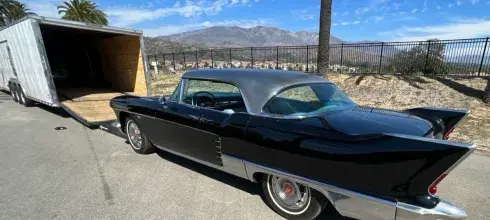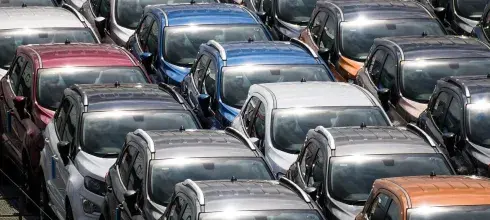One of the things we pride ourselves on here at SGT Auto Transport is our adaptability and flexibility for answering customers’ needs. That means we have developed a whole range of shipping options for various types of vehicles, various budgets and various situations, and that includes being able to ship oversize vehicles for our customers. Here’s a quick rundown on what goes into getting an oversize vehicle to its destination.
What is Oversized Car Shipping
If we were to put a definition on it, “oversize car shipping” would mean the type of handling and logistics needed to get any kind of vehicle other than a stock sedan, SUV or pickup to its destination. That’s pretty inclusive, though, and covers a lot of ground, so let’s break it down further.
Types of Vehicles That Require Oversized Shipping
These are some of the vehicles that could be considered oversize and that would need special handling or procedures to ship them:
- Sprinter commercial vans
- Step-vans and food trucks
- Military vehicles
- Pickup trucks with lift kits and oversize tires
- RVs
- Medium-duty commercial trucks
- Tractors or ag equipment
Common Scenarios for Shipping Large and Modified Vehicles
Technically, any vehicle that’s over 25 feet long, 82 inches tall and 80 inches wide will be considered “oversize.” Considering the various types of vehicles and trucks that would be classified as “oversize” or “modified,” there are all kinds of situations that would require differing types of solutions to safely handle, secure and ship these vehicles.
How Oversized Vehicle Transport Differs from Standard Shipping
There are all kinds of considerations that have to be taken into account to ship an oversized vehicle. The transport driver will probably need a different kind of vehicle or trailer (such as a lowboy trailer), handling and loading can be more complex, different methods might be needed to secure the vehicle onto the trailer. For extremely oversize loads, the routing might have to be rearranged to account for low clearances or load limits on bridges. Carriers often need enhanced insurance coverage to manage these shipments as well, as well as specialized permits and documentation.
How to Ship Modified and Lifted Trucks
One of the most important factors for shipping a modified or lifted truck will start with you, the customer. The logistics company will need to know what they’re getting into; that includes tire size, lift kit info, ground clearance and any other modifications or custom features. This info will be critical for assigning this job to a transport driver with the proper trailer, equipment and insurance coverage.
Special Requirements for Transporting Lifted Trucks
Depending on your truck’s lift kit, modifications and overall dimensions, it may or may not fit onto a standard transport trailer along with other vehicles. If that’s the case, the transport company might need to assign it to a driver with a specialized tractor/trailer rig. When special arrangements like that have to be made, it’s a good idea to give the logistics broker plenty of lead time to line things up - as long as a month in advance, perhaps.
Best Practices for Shipping Modified Vehicles
Aside from being sure that your carrier is fully informed about your vehicle and any special arrangements that might be needed, you can help by making sure it’s ready to go:
- Ship your truck with a quarter tank to ⅛ tank of gas, helping to keep curb weight down and cut your shipping costs.
- Give your truck a good wash job, making it easier to document its condition pre-shipping.
- Secure or remove any loose parts such as brush guards, antennas, cargo boxes or toolboxes.
- Check your tire pressure and be sure all four tires are fully inflated.
- Disable any alarms, and remove any personal items from the vehicle.
- Check your truck for leaks: motor oil, coolant, transmission, brake or power steering fluid. Carriers might refuse to transport a vehicle that’s leaking.
Choosing a Carrier for Your Lifted Truck Shipping Needs
The biggest thing you should keep in mind when choosing the right carrier for a lifted truck is their experience with these vehicles. Ask questions, do some due-diligence research to find out what they have to offer when it comes to specialized transport jobs like this. What’s their insurance coverage like for specialty vehicles? Do they have drivers who have the proper equipment and experience for the job?
How Much Does Oversized Vehicle Transport Cost?
Considering all the variables that are at play when it comes to shipping an oversize vehicle, it’s pretty hard to give a cut and dried answer for that question. In general, shipping should cost anywhere from $500 to $2000, but we can break it down further.
Factors that Affect Large Vehicle Transport Costs
These are some of the things that affect billing calculations and cost formulas for shipping large vehicles:
- Curb weight of the vehicle
- Distance to be covered
- Timeframe of the shipment
- Enhanced insurance coverage
Weight, Dimensions, and Modifications: Impact on Pricing
- Curb weight is a standard factor in determining pricing for shipping any vehicle. The more a vehicle weighs, the more expensive shipping costs will be, and it’s advisable to cut weight whenever possible (such as shipping with a quarter tank of gas, as gasoline weighs about 6 lbs per gallon).
- Dimensions come into consideration when the truck is too big to fit into a standard enclosed trailer or open-transport double-decker trailer and some type of other, specialized trailer is necessary.
- Modifications like a lift kit or overhead light bar can make a truck too tall to fit into the above-mentioned trailers, necessitating other arrangements.
Comparing Costs for Open vs. Enclosed Transport
Like shipping any other vehicle, open transport is always going to be the more budget-friendly way to go. Enclosed transport does mean an enhanced level of security and protection for the vehicle, but it can also be more difficult to arrange and will come at a premium cost.
Shipping Large Commercial Vehicles: Food Trucks, Sprinter Vans, and More
Food trucks have really proliferated in the last couple of decades; they’re now a popular culinary option that can serve as a mobile kitchen to take the “restaurant” to where the people are instead of the other way around. These trucks usually were designed as route delivery or service vehicles, built on one-ton truck chassis, and they’re quite large and bulky. Food trucks and Sprinter vans have their own concerns that have to be taken into account for logistics purposes.
How to Safely Ship a Food Truck Long-Distance
A food truck isn’t just a vehicle: it’s a business and an investment. Here are a few tips for safely transporting your food truck:
- Prepare the truck by securing any loose items in the kitchen, including kitchenware, ovenware, tools and supplies.
- Cut off systems for electrical, gas and water and disconnect them if necessary.
- To avoid leaks or explosions, release any pressure in gas tanks and ovens.
- Unplug and secure any electrical outlets or ports.
- Remove and secure any external accessories such as lights, counters or awnings.
- Depending on how your food truck is equipped, think about whether you might need enclosed and climate-controlled transport.
- Think about whether you might need moisture barriers or shrink wrap to protect any sensitive equipment in the kitchen.
Transporting Sprinter Vans: What You Need to Know
High-profile Sprinter and Freightliner vans have become a very popular option as commercial vehicles; they’re roomy and practical, and surprisingly fuel-efficient considering their size. Here are some things to keep in mind for shipping a Sprinter:
- The shipping company will need to know the van’s dimensions: height, length, width and curb weight, along with its running conditions (operable or inoperable).
- Pickup and dropoff locations can also be a factor, as many tractor-trailers for auto transport can be as long as 80 feet and can’t access certain neighborhoods and streets.
- Special handling might be necessary for mobility vans, wheelchair vans or certain types of commercial vans.
- Depending on the shipping company, it might be necessary to ship a Sprinter on an open deck trailer.
Best Methods for Shipping Commercial and Utility Vehicles
The more the shipping company can find out about the vehicle, the better off they’ll be when it comes to making the right determinations for shipping options. For instance, a Ford E-series or Transit van, a Chevrolet Express or RAM ProMaster will usually fit onto an open transport trailer with ease, while a M-B Sprinter, Nissan NV series or Ford Transit Connect will need to be on a flatbed. Commercial and utility vehicles will also need to be secured with straps and possibly chains for safety.
Military Vehicle Shipping: Safe and Secure Transport Solutions
Military vehicles have their own special concerns, whether they’re obsolete pieces that were bought by collectors or modern equipment that needs to go to another location.
How to Prepare Military Vehicles for Transport
When you’re readying a military vehicle for transport, many of the same guidelines apply:
- Ship your truck with a quarter tank to ⅛ tank of gas, helping to keep curb weight down and cut your shipping costs.
- Give your truck a good wash job, making it easier to document its condition pre-shipping.
- Secure or remove any loose parts such as brush guards, antennas, cargo boxes or toolboxes.
- Check your tire pressure and be sure all four tires are fully inflated.
- Disable any alarms, and remove any personal items from the vehicle.
- Check your truck for leaks: motor oil, coolant, transmission, brake or power steering fluid. Carriers might refuse to transport a vehicle that’s leaking.
Key Considerations for Safe Military Vehicle Hauling
- Be sure the vehicle is properly prepared, as outlined above
- Check to see if there are any special permits or documentation needed, especially if the shipment means crossing multiple states
- Make sure that any enhanced insurance coverage is in place
Finding a Carrier Experienced in Military Vehicle Transport
This is where you really need to do your due diligence in selecting the right carrier. Make sure they’re experienced with these vehicles and don’t be afraid to ask questions. Be sure they’ve got the proper permits and required licensing, choose a company with transparent and responsive customer service, and shop between a few companies to find out their rates.
Preparing Your Oversized Vehicle for Shipping
- Ship your truck with a quarter tank to ⅛ tank of gas, helping to keep curb weight down and cut your shipping costs.
- Give your truck a good wash job, making it easier to document its condition pre-shipping.
- Secure or remove any loose parts such as brush guards, antennas, cargo boxes or toolboxes.
- Check your tire pressure and be sure all four tires are fully inflated.
- Disable any alarms, and remove any personal items from the vehicle.
- Check your truck for leaks: motor oil, coolant, transmission, brake or power steering fluid. Carriers might refuse to transport a vehicle that’s leaking.
Enclosed Shipping for Large and Oversized Vehicles
Enclosed shipping is applicable for some oversize vehicles, depending on their size and weight.
When to Choose Enclosed Transport for Oversized Vehicles
If your oversize vehicle is in delicate condition, has any sensitive external equipment or is in non-running condition, enclosed transport has its advantages.
Benefits of Enclosed Transport for High-Value Vehicles
Enclosed transport for high-value vehicles means less exposure to weather or curious onlookers, with an enhanced level of security and protection.
Cost Comparison: Enclosed vs. Open Transport for Large Vehicles
The downside of enclosed transport is that availability of drivers and trucks can be scarcer, and it’s almost always going to come at a premium price.
Choosing the Right Company for Oversized Vehicle Shipping
As mentioned above, due diligence is in order; ask questions, research several different companies, look for customer reviews on logistics forums and again, ask more questions.
What to Look for in an Oversized Vehicle Transport Specialist
- Experience
- Customer service
- Proper equipment
- Accountability and trustworthiness
Safety Standards
Safety is always going to be the #1 concern for shipping oversize vehicles. Make sure your carrier has the right equipment and the right processes for securing any oversize vehicle for shipment.
How to Get an Accurate Quote for Oversized Vehicle Transport
While SGT Auto Transport has a Quote Calculator feature to make it easier to obtain an accurate estimate, you might need to actually call and talk to a customer service rep to give us a better understanding of your vehicle, your budget and your specific needs. The more information and details you can give us, the better we can serve you.
Information Needed to Provide an Accurate Quote
- Curb weight
- Timeframe
- Any special equipment
- Vehicle dimensions
- Departure and destination points
How Vehicle Size, Weight, and Destination Affect Quotes
Size, weight and destination are all key factors in rate formulations. Cost/mile needs to be calculated (although cost/mile drops for very long runs) and oversize or very heavy vehicles will need specialized equipment.
Factors That Influence Oversized Vehicle Transport Timing
- Driver and truck availability
- Distance to be covered
- Seasonal surges or possible delays due to weather, traffic, road conditions, detours
How Location and Distance Affect Delivery Time
The standard rule is that deliveries of 200 miles or less can be done in a day’s time, but that can stretch out for very long runs and in some cases, very heavy vehicles may have to be rerouted in ways that are less direct and can mean a longer delivery time.
Vehicle Size and Weight’s Impact on Transit Times
As mentioned above, a very heavy or very large vehicle will need special handling and it can take more time to line that up. Think about giving your carrier more lead time to set things up for a smooth and timely delivery.
Safety for Oversized Vehicle Shipping
- Proper loading, including positioning the truck on the trailer for the right weight distribution
- Properly securing the vehicle with straps, chains, binders
- Ensuring the transport truck is well maintained with lights, brakes, safety equipment that are all in good shape
- Pre-inspection on the part of the driver before departing with the load
Ensuring Your Vehicle Is Insured During Transport
Ask all the necessary questions with your carrier to make sure the proper insurance coverage is in place, and consider shopping around with a few providers.
Safety Protocols for Hauling Large and Heavy Vehicles
- Proper loading, including positioning the truck on the trailer for the right weight distribution
- Properly securing the vehicle with straps, chains, binders
- Ensuring the transport truck is well maintained with lights, brakes, safety equipment that are all in good shape
- Pre-inspection on the part of the driver before departing with the load
How to Communicate Effectively with Your Carrier
Be ready to ask the necessary questions, and be ready to answer all the questions they might have for you. Be sure that your carrier has a good customer service department that’s available when you need them.
Avoiding Common Mistakes When Shipping Large Vehicles
- Don’t just go with the cheapest option available
- Do give plenty of information to the shipping company
- Don’t neglect vetting and background research on your carrier
- Understand the basics of what’s required for shipping your vehicle
Ensuring Safe Delivery with Proper Documentation
Your logistics broker should have all the necessary DOT permits, licensing, documentation and registrations for your oversize vehicle shipping. It can get complex, especially state-by-state and in light of any special DOT requirements for interstate shipping. Don’t be shy about asking to make sure this is all in place!







